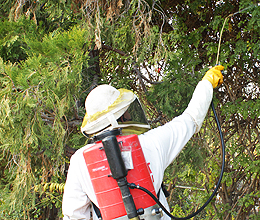
Sometimes the bees are inside a structure that is impossible or expensive to open, like inside concrete. Other times the hive may be located near a sensitive site like a school or hospital. If a homeowner is allergic, an elimination may be safer than a live removal. Public safety is always our number one priority. We will not perform a live removal if it puts our clients’ families, neighbors, and/or pets at risk. Not only do we take the danger out of beehive removal, but we also remove live hives in the most humane way. Some bees are protected because they are vital to our environment. Honeybees, for example, pollinate our flowers and bring us delicious honey that is good for our health. If a beehive does not pose a viable threat to your family, we will use specialized removal methods that keep you safe and resolve the problem.
APA Bee Removal is licensed by the Structural Pest control board and can provide traditional pest control measures whenever necessary. Although we prefer to remove bees live, it is not always possible. The role of bees in Earth is especially important; pollination is an important part in the processes that involve nature. When thinking in a beehive removal, you must think about the preservation of the hive and the lives of the bees. Normally they do not represent any danger but is better to control it, so make the right decisions and ask for help from professionals.
Where an elimination is the best choice for controling bees.
1. When they are inside a structure that is too expensive to open
2. When the bees display aggressive characteristics and put public safety at risk.
3. When a hive is fully established and it is inside a hard to reach area that can’t be opened.
4. When children, pets, allergic or elderly people may be affected.
Bee Control Tips
1. CHECK YOUR PROPERTY FOR BEE HIVES
The best defense is a strong offense. Be on the lookout for signs of a bee infestation by regularly inspecting your property and home. The sooner you spot the bees, the sooner you can get a professional live bee removal company to the scene to take care of the problem. Remember, honeybees can do a lot of damage to your home if left to their own devices
2. REMOVE WATER SOURCES
Honeybees need nectar, pollen and water. They will always choose a shelter that is in close proximity to a water source. If you remove a nearby water source, you will decrease the likelihood that bees will choose your property to build a hive. Check your property for leaky faucets or lawn watering systems. Eliminate birdbaths, or add a little vinegar to the water to deter bees.
3. ELIMINATE CLUTTER FROM YOUR YARD
When looking for a place to build their homes, honeybees love to choose locations that are safe, warm and protected from rain and wind. Yard clutter such as trash cans, old vehicles, machinery, boxes, woodpiles and gardening pots can be perfect shelters for honeybees. Inspect your property for secluded, protected places that would attract bees and clean them up.
4. INSTALL SCREENS ON WINDOWS , DOORS AND OHER OPENIING
One of the simplest and most effective ways to prevent honeybees and other bugs from entering your home is to install screenson your windows and doors. Not only do screens block pests from entering your home, they still allow for ventilation. If you have screens already installed, check to make sure that there are no holes and that the frames are not bent. Screens can also be installed on other larger openings like laundry vents and around pipes.
5. CHECK FOR GAPS IN YOUR DOORS AND WINDOWS
We’d bet that if you inspected the outside of your home with a critical eye, you would find plenty of small openings, cracks and crevices big enough for a honeybee to enter through. In fact, honeybees can enter spaces through holes the size of a pencil eraser – that’s about 1/8-inch! The first line of defense in preventing honeybees from building a hive in your home is to block all potential access points. Here are some steps you can take to cover holes and openings that bees can use as their door to your home: Install door sweeps Check all seals around your doors and windows Caulk cracks and holes in walls, around window and door frames and in your foundation

